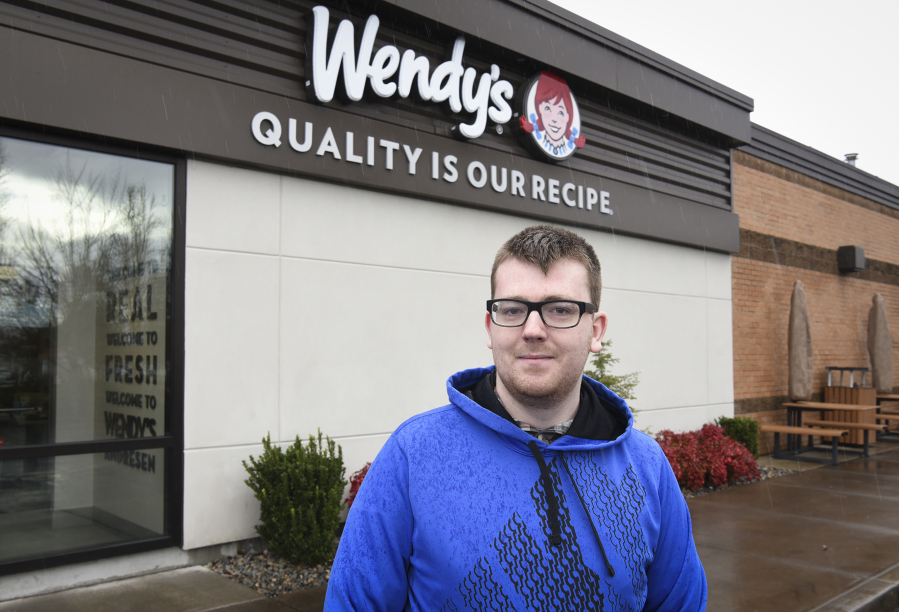“Everybody is going to the handheld (tablets),” Brent said. “It’s been received very well. My servers are getting very adept at punching in the orders through the handheld.”
Initiative 1433, passed in November, goes into effect today. It raises the minimum wage to $11 per hour, with 50-cent increases the next two years then a $1.50 bump to $13.50 in 2020.
Thousands of Clark County workers received raises to the new minimum today. Industries with many low-wage workers, like restaurants, hotels and gas stations, worry about ballooning payroll costs. But proponents of the raise, like the thousands of workers who qualify, say the new wages will help them keep pace with the rising costs of education or the booming housing markets along the Interstate 5 corridor.
“It’s really a chance to bring more money home, more money into our pockets,” said 18-year-old Dennis Jeppson, a worker at Wendy’s at the corner of Northeast 88th Street and Northeast Andresen Road.
Employers
Shortly before noon on a recent Thursday, the Mill Creek Pub is already bustling. It opened five years ago along state Highway 503 in Battle Ground. Its homesteading theme, with horseshoes on the wall and a 10-foot-high water wheel revolving near the entryway, creates a sense of living by one’s own means.
Like many restaurants in Washington, it has spent the last 60 days staring down a budgetary conundrum. How can it absorb a projected 20 percent rise in payroll costs without scaring customers away? The restaurant employs 42 minimum-wage employees — and 25 workers who earn just above minimum who might ask for proportionate raises — and Brent said he and other restaurants are facing three options: raise menu prices, cut payroll costs, or try to ride it out.
Brent hopes to make the pub more efficient and wring out more revenues — hence the new tablet computers and programmable oven.
“Imagine if I was to raise my menu prices 30 percent (today)? Right now, we’re selling hamburgers for $10 to $13 — how much are you willing to pay for a hamburger? Are you willing to pay $15 to $18 for a hamburger?
“Everybody is going to have to raise prices,” Brent said. “But the question is, how much?”
Restaurants will need a soft touch, or else risk sending customers fleeing to cheaper options. It’s a trend most typically seen during economic downturns — customers trading down when prices become impractical.
The other option is taking the tablets and programmable ovens to the next level, like the self-serve kiosks being wheeled out in McDonald’s locations to replace customer service employees. Similarly, Applebee’s, Chili’s and other fast-casual dining establishments have automated food ordering altogether with touch screens at the table.
“Fast food already has the answer to this,” Brent said.
There are concerns, too, about whether rural business may be hit harder. The Washington Hospitality Association, which represents restaurants and hotels statewide, echoed an editorial from The Seattle Times suggesting the state should have structured its minimum wage increase like Oregon, where the raises vary in rural and urban areas.
“The Legislature should consider phasing in the $13.50 wage more slowly for low-cost rural areas,” the association wrote in an email to The Columbian.
Crunching numbers
It remains to be seen how hard businesses are hit, but economic data supplied by the Washington Employment Security Department suggest the payroll costs will be negligible.
Using data from the last full year, 2015, and adjusting for inflation, employers will pay $15.9 million to raise employees up to the new minimum wage. Nearly 10,000 employees, most of whom work in the restaurant industry, received the raise.
While that collective wage hike seems expensive, it represents 0.2 percent of all the wages earned in Clark County in 2015 — or $6.5 billion.
“This may sound like a lot of jobs, but to bump them up is not going to take that much,” said regional economist Scott Bailey. “Of course, there are some industries where the impact is bigger.”
The restaurant scene employed the most workers who qualify for the state-mandated raise. Its 2,045 employees in 2015 account for $3.8 million in raises — or 4.4 percent of wages earned in Clark County’s restaurant industry.
Gas stations, the second-biggest employer of such workers, would spend $607,068 — or 3.3 percent — to raise up its 349 workers who made less than the new minimum.
On the flip side, that $15.9 million bump in payroll could be money that comes right back to the local economy. Lower-wage workers are more inclined to spend, Bailey said.
“It’s not a direct offset … but some of that will flow right back in,” Bailey said. “I respect how some individual businesses might struggle, but in the bigger picture, the overall impact won’t be as large.”
Employees
On the flip side, many employees say they are facing dire circumstances. Many of them are younger, facing high prices in housing and higher education.
Jeppson, the Wendy’s worker who lives in Orchards, faces student debt from tuition for Clark College. His family faces medical bills from his father’s heart attack in 2007.
“We live a block from the hospital and had to pay for the ambulance ride, the medical costs, health insurance. We were paying that off for years after that happened,” he said.
Until Saturday, Jeppson, who interned for the Washington State Democrats during the election cycle, made $9.57 per hour. While he expects businesses to make cuts to offset higher labor costs, he attributes that to businesses realizing they need to be more scrutinizing of their expenses.
“It’s cutting the fat,” he said. “They will say, ‘I’ve go this employee who has been working here a year, they do a great job, (versus) someone who has floated around for a couple years. I think I will reward the good employees.’ ”
Similarly, Tristen Walz makes $11.50 an hour and won’t get a raise from his employer. The 20-year-old said at first he felt his work undermined by the minimum-wage increase, but many of his friends who are working hard to make a living will benefit.
“I shouldn’t have to be upset that my friends who work fast food should have a livable wage,” he said. “I shouldn’t be mad that somebody is working to provide for themselves. Everyone seems to think this is going to ruin the economy, but it never ruined it before. Think about how easy it used to be to buy a car or house when you worked in a grocery store.”




